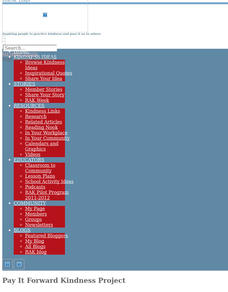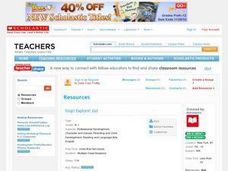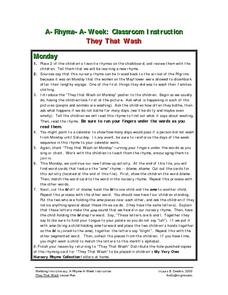Little Giraffes Teaching Ideas
Snowman Snowman
What do snowmen eat? Or smell? Read about the senses of a snowman with a cute picture book. Kindergartners cut or fold the pages to create a story about a snowman and what he sees, smells, hears, eats, and feels.
Barbara Kowal
Winter Picture Test: Fill in the Missing Letters
What words come to mind when you hear the word winter? Snowflake, cold, and icicles are just a few of the winter words included in picture-test learning exercise. Given a partial word, young readers name 10 pictures by filling in the two...
Read Works
Edison Tried and Tried Again
How many times did it take Thomas Edison to invent a successful working lightbulb? Young learners read a short passage about this famous inventor and his determination in getting an idea to work successfully. Then, pupils respond to four...
Harper Collins
Let the Wild Rumpus Start!
Accompany a reading of the story, Where the Wild Things Are by Maurice Sendak, with an activity booklet featuring five worksheets created to continue to the learning experience. Scholars solve a maze, draw a picture, search for Max,...
K5 Learning
All About Bears
Want to know all about bears? Read a passage about the way they look, how they live, and their lifestyles. The reading passage is followed by questions that ask what baby bears are called and in what ways some bears are different, to...
K5 Learning
A Cold Bear
Who is the main character and how does this character prepare for winter? As learners read a short passage, they think about how the bear is preparing for hibernation and respond to five questions about what they read.
K5 Learning
Making Cookies
What kind of cookies is Greg making? Can class members identify the order in which each ingredient is added? After reading a brief passage, pupils respond to four short answer comprehension questions.
K5 Learning
Time for Everything
Read a historical fiction poem that explains how there is a time for everything in our daily lives. From sitting to sleeping, pupils read a rhythmic poem and respond to four comprehension questions.
K5 Learning
Seven Little Mice
Which days of the week does each mouse find a bun? Is it Monday through Sunday, or Sunday through Saturday? Read a poem about the adventures of the seven mice during the days of the week, followed by four reading comprehension questions.
K5 Learning
My Little Kitty
Can the small cat catch the rat? Find out in a short passage designed for first graders, complete with four comprehension questions that address details from the text.
Florida Center for Reading Research
Phonological Awareness
Kindergarteners and first graders alike are engaged as they learn the initial sounds of objects by taking turns flipping cards to form a long train. This complete and ready-to-print activity helps young ones build the basic foundations...
Library of Congress
The Story of The Three Little Pigs
Bring the 1904 version of the classic kid's tale, The Story of the Three Little Pigs to your young readers. With original drawings by L. Leslie Brooke, young reader take a step into a world where pigs can talk and a wolf is big and bad.
Curriculum Corner
December Writing Journal
December writing activities galore! With everything from poetry to research to descriptive writing to writing about things that represent December, there's no way you will run out of options.
K12 Reader
Adjectives: Which Noun Does It Describe?
Adjectives can come before or after the noun they describe. Eight simple sentences prompt learners to circle the noun that each underlined adjective is describing.
Rosetta Stone
Sight Word Flashcards
While kindergarten readers are working on the, my, and is, older elementary learners are mastering although, usually, and beautiful. Help readers of all ages work on sight words that do not follow phonics rules, but are key to reading...
Learning A-Z
Tips for Teaching: Word Recognition
Learning to read can be exhilarating for some pupils, but for others, it's difficult to get past the frustration of not knowing how to read a particular word. A tutoring resource provides several ways to guide class members into...
Curated OER
Telling Stories Through Dance
Examine the movement of characters in the story, Caps for Sale. Using the text, pupils invent gestures and movements for some of the actions and major events. They practice retelling a story by using the movements they developed. They...
Curated OER
Introduction to Primary Sources
Students explore the usage of primary sources, what they are and how they originate. Artifacts are compared and contrasted as part of this historical inquiry as questions are formulated and conclusions drawn.
Curated OER
Who Works at Our School?
Young interviewers will learn more about the school staff by asking them questions and creating a bulletin board display. They will learn how to make thoughtful interview questions, conduct professional interviews, and organize...
Curated OER
Bringing Animal Issues Into the Classroom
Here's an excellent packet of worksheets that delves into animal issues, and also covers the people who work in the community who help animals, such as veterinarians. There are thought-provoking questions associated with photographs of...
Curated OER
Unique Monique: Building a Community of Unique Individuals
Young scholars recognize that each student is unique and has special talents. Students develop a puzzle piece that describes them and their particular talents. Young scholars share their pieces and post on a bulletin board.
Curated OER
Pay It Forward Project
Create a list of random acts of kindness and have your class perform them during a designated week. Learners will also participate in a project centered around being kind to others. Each grade chooses their kindness project, and then...
Curated OER
Stop! Explore Go!
Students examine a three-step process for making decisions and how their peers can influence them in different ways. They role-play different roles when making decisions and other students reflect on how they feel about the activity.
Curated OER
They That Wash
Scholars examine the "They That Wash" poster and listen to the rhymes. They match word cards to the words in the nursery rhyme, practice sounds, and create new words. Afterward, they add copies of the rhyme to their "My Very Own Nursery...

























